
[Boyd]_cvxslides
.pdfGeneralized inequalities
a convex cone K Rn is a proper cone if
•K is closed (contains its boundary)
•K is solid (has nonempty interior)
•K is pointed (contains no line)
examples
•nonnegative orthant K = Rn+ = {x Rn | xi ≥ 0, i = 1, . . . , n}
•positive semidefinite cone K = Sn+
•nonnegative polynomials on [0, 1]:
K = {x Rn | x1 + x2t + x3t2 + · · · + xntn−1 ≥ 0 for t [0, 1]}
Convex sets |
2–16 |
generalized inequality defined by a proper cone K:
x K y y − x K, x K y y − x int K
examples
• componentwise inequality (K = Rn+)
x R+n y |
xi ≤ yi, i = 1, . . . , n |
• matrix inequality (K = S+n ) |
|
X S+n Y |
Y − X positive semidefinite |
these two types are so common that we drop the subscript in K properties: many properties of K are similar to ≤ on R, E.G.,
x K y, u K v = x + u K y + v
Convex sets |
2–17 |
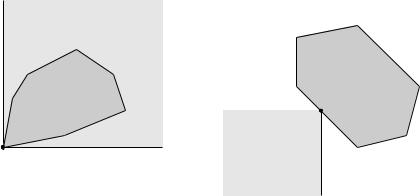
Minimum and minimal elements
is not in general a linear ordering: we can have x 6 y and y 6 x
K K K
x S is the minimum element of S with respect to K if
y S = x K y
x S is a minimal element of S with respect to K if
y S, y K x = y = x
example (K = R2+)
x1 is the minimum element of x2 is a minimal element of S2
S1 |
S2 |
x2 |
|
S1 |
|
x1 |
|
Convex sets |
2–18 |
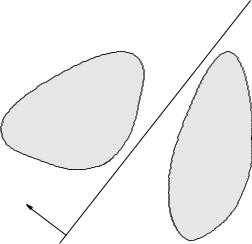
Separating hyperplane theorem
if C and D are disjoint convex sets, then there exists a 6= 0, b such that
aT x ≤ b for x C, aT x ≥ b for x D
aT x ≥ b aT x ≤ b
D
C
a
the hyperplane {x | aT x = b} separates C and D
strict separation requires additional assumptions (E.G., C is closed, D is a singleton)
Convex sets |
2–19 |
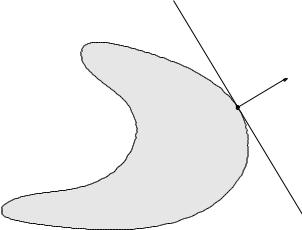
Supporting hyperplane theorem
supporting hyperplane to set C at boundary point x0:
{x | aT x = aT x0}
where a 6= 0 and aT x ≤ aT x0 for all x C
a
C x0
supporting hyperplane theorem: if C is convex, then there exists a supporting hyperplane at every boundary point of C
Convex sets |
2–20 |
Dual cones and generalized inequalities
dual cone of a cone K:
K = {y | yT x ≥ 0 for all x K}
examples
•K = Rn+: K = Rn+
•K = Sn+: K = Sn+
•K = {(x, t) | kxk2 ≤ t}: K = {(x, t) | kxk2 ≤ t}
•K = {(x, t) | kxk1 ≤ t}: K = {(x, t) | kxk∞ ≤ t}
first three examples are self-dual cones
dual cones of proper cones are proper, hence define generalized inequalities:
y K 0 yT x ≥ 0 for all x K 0
Convex sets |
2–21 |
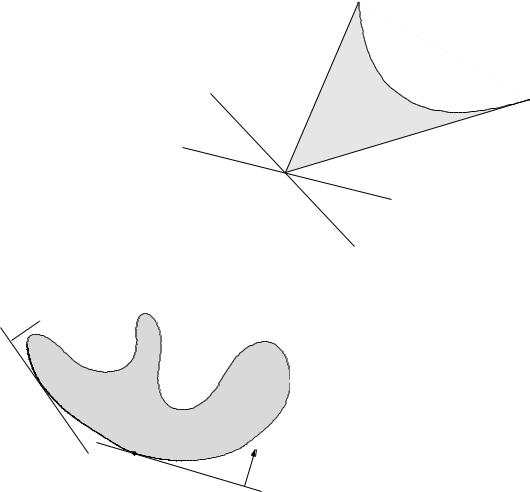
Minimum and minimal elements via dual inequalities
minimum element w.r.t. K
x is minimum element of S i for all λ K 0, x is the unique minimizer of λT z over S
S
x
minimal element w.r.t. K
• if x minimizes λT z over S for some λ K 0, then x is minimal
 λ1
λ1
x1 S
S
λ2
x2
•if x is a minimal element of a convex set S, then there exists a nonzero λ K 0 such that x minimizes λT z over S
Convex sets |
2–22 |
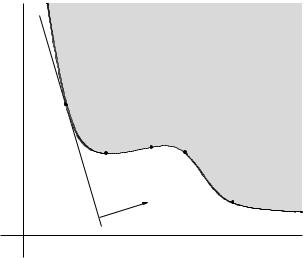
optimal production frontier
•di erent production methods use di erent amounts of resources x Rn
•production set P : resource vectors x for all possible production methods
•e cient (Pareto optimal) methods correspond to resource vectors x that are minimal w.r.t. Rn+
example (n = 2)
x1, x2, x3 are e cient; x4, x5 are not
fuel |
|
P |
|
x1 |
|
x2 x5 x4 |
|
λ |
x3 |
|
|
|
labor |
Convex sets |
2–23 |
Convex Optimization — Boyd & Vandenberghe
3.Convex functions
•basic properties and examples
•operations that preserve convexity
•the conjugate function
•quasiconvex functions
•log-concave and log-convex functions
•convexity with respect to generalized inequalities
3–1
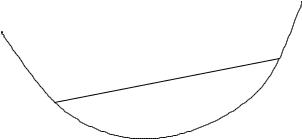
Definition
f : Rn → R is convex if dom f is a convex set and
f(θx + (1 − θ)y) ≤ θf(x) + (1 − θ)f(y) for all x, y dom f, 0 ≤ θ ≤ 1
 (y, f(y))
(y, f(y))
(x, f(x)) 
• f is concave if −f is convex
• f is strictly convex if dom f is convex and
f(θx + (1 − θ)y) < θf(x) + (1 − θ)f(y) for x, y dom f, x 6= y, 0 < θ < 1
Convex functions |
3–2 |
